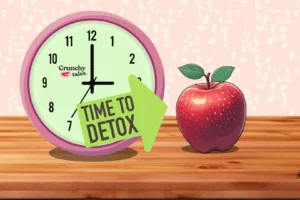Sugar Addiction: 10 Tips To Cut The Cravings In Midlife
Sugar is seductive and everywhere. It’s in soda, cookies, candy, and even seemingly healthy foods like yoghurt, tomato sauce, and soup. But it’s addictive and during the hormonal rollercoaster phase of menopause, when we often need a pick-me-up to challenge stress and mood swings, detoxing our life from this innocent-looking substance is not an easy road.
In this article, our expert, Dr Ellen Albertson, psychologist, registered dietitian, board-certified health and wellness coach, will help us to find the best way to reduce your intake of added sugar in your diet.
According to the Center for Disease Control, the average American adult consumes 17 teaspoons of sugar a day. That’s about 60 pounds a year! No wonder why, among researchers and medical professionals, sugar addiction continues to be a hot topic of debate.
Added sugar in midlife is typically the culprit behind health issues like weight gain, high triglycerides, low HDL cholesterol, high blood pressure, high blood sugar, obesity, and heart disease but still, sometimes knowing that doesn’t help.
Its addictive-like properties make it difficult for us to cut it back also because most of the time we don’t know what we’re eating when we buy products from the grocery.
Although The American Heart Association recommends about 6 teaspoons (25 grams or 100 calories) a day for women, it’s a goal difficult to achieve for many of us given that a 12-ounce can of soda contains 8 teaspoons (32 grams) of added sugar.
Adding sweetener high fructose corn syrup (HFCS) to our drinks or foods it’s even worse. Studies show that it can promote weight gain around the dreaded middle and is associated with decreased appetite regulation (which means it’s easy to eat too much) as well as alteration of dopamine signalling (the hormone of pleasure and reward).
But don’t despair, while it can be challenging, there are gradual, sustainable changes you can make to reduce your intake of added sugar and break the “addiction”.
10 Tips to curb your sugar consumption
It’s interesting to note that, according to a 2021 Food & Health Survey conducted by the International Food Information Council, 72 per cent of people are trying to limit/avoid sugars.
If you are one of them, here are 10 tips to help you get back right on track.
1) Determine your why and set goals
Before you start take out your journal and determine why you want to end your “sugar addiction.” Do you want to lose weight? Improve your health? Have more stead energy?
Next, write down specific actions you will take. For example, “I will have a piece of fresh fruit or a small handful of nuts instead of cookies as my afternoon snack. Or I will drink water instead of soda”.
2) Go slow
While it can be tempting to go cold turkey, this strategy may backfire especially if you’ve been consuming a lot of sugar.
You may experience uncomfortable symptoms from withdrawal including intense cravings for sweets, irritability, anxiety, fatigue, and depressed mood which can make you want to binge on sweets.
A gradual reduction is much easier on the body and brain, which depends entirely on blood sugar for fuel. Once you and your taste buds get accustomed to eating less sugar you can decide whether to cut it out completely.
3) Swap sweetened beverages for unsweetened ones
Many of my clients start by replacing soda, energy drinks, sweetened juices, and sweetened tea/coffee with water, unsweetened tea/coffee or club soda flavoured with lemon or lime.
Make sure to stay hydrated as hunger can sometimes be mistaken for thirst and hydration can make you tired or anxious which can increase cravings for sweets. Shoot for 64 ounces a day. And if you drink cocktails choose unsweetened mixers.
Don’t make the mistake of using artificial sweeteners such as saccharin or aspartame as a substitute for sugar. Some research suggests that they can activate reward pathways and increase hunger and sugar cravings. Stevia and erythritol are okay to use because they don’t spike insulin or glucose levels.
4) Reduce portions
Share a dessert. Have one cookie rather than two or a mini candy bar instead of a full-sized one. You may discover that one Hershey’s kiss is as satisfying as a whole chocolate bar especially when eaten mindfully.
5) Eat more whole foods
Whole, unprocessed foods like fruits, vegetables, whole grains, and lean proteins are free of added sugars. They are also high in fibre which can help you stay full longer so you’re less likely to reach for sweets.
To have more control over what you eat cook more meals at home using whole unprocessed ingredients. You can also make your own nutritious, low-sugar baked goods by using fruit such as mashed bananas, crushed unsweetened pineapple or unsweetened applesauce.
6) Read labels and choose unsweetened options and sugar-free products
Have plain yoghurt with sliced fruit instead of the sweetened variety. Choose unsweetened oatmeal, cold cereals, and nut milks. Look for unsweetened varieties of packaged foods like salad dressings, crackers, and condiments. Craving chocolate? Have a small handful of unsweetened cocoa nibs.
Educate yourself about the names of added sugars and read the list of ingredients on food labels. Labels for foods and beverages with added sugars now list the number of grams and the per cent Daily Value (%DV) for added sugars within the Nutrition Facts label. Common sweeteners include sugar, brown sugar, cane sugar, honey, maple syrup, sucrose, high fructose corn syrup, and agave.
7) Smart snacking
Hunger can reduce willpower so carry healthy snacks such as a piece of fruit, string cheese, or a handful of nuts. When you’re hungry between meals and want a snack reach for fresh fruits, cut-up veggies, nuts, or plain yogurt.
8) Manage stress
Stress can increase cravings for sweets and impact your food choices, so find ways to manage. Good stress reduces include exercise, meditation, spending time in nature, yoga, or breathwork. Make sure you’re eating magnesium as it can help you relax. Drink soothing herbal teas or use calming essential oils such as lavender.
9) Sleep well
Lack of sleep can make you tired and negatively impact appetite hormones both of which can increase cravings for sweets. Aim for 7-8 hours of quality sleep a night.
10) Remember to HALT
HALT stands for Hungry, Angry/Anxious, Lonely, Tired. It’s a great acronym to remember when you’re about to reach for sweets especially if you are an emotional eater.
If you’re truly hungry, fix yourself a healthy meal or snack. However, if you are angry, anxious, lonely, or tired acknowledge how you are feeling and find an activity that will address the issue.
As you kick the sugar habit be sweet to yourself and focus on progress, not perfection. If you slip up and binge on sugar, learn from your mistakes and course correct. The more loving and accepting you are towards yourself the easier it will be to stay on track.
Like this post? Support Us or Sign up to our newsletter to get more articles like this delivered straight to your inbox!






